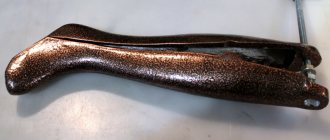After I was given an expensive mechanical watch, I seriously began to take proper care of it. Often people neglect the issue of lubrication and do not even know what it is needed for. It is necessary to protect moving elements from wear. For this, watch oil is used, which periodically lubricates miniature parts at approximately 50 points. Without such a procedure, the clock mechanism will soon become unusable.
Source ebayimg.com
Prologue
I absolutely hate buying new things, especially when I have to choose between Chinese and Turkish consumer goods of the lowest quality. Maybe that's why my family still uses Soviet-made mechanical and electromechanical watches.
Throughout the life of this watch, I cleaned and lubricated it several times. But, each time the result was worse and worse.
I lubricated the watch with MTs-3 and MBP-12 oils, which I got hold of when I was still working in production.
MC-3 oil is used to lubricate the journals of large gears, and MBP-12 oil is used for the most delicate parts of the watch mechanism - the balance supports and the anchor mechanism, as well as the pallets and impulse stone of the latter.
The trouble is that after fifteen to twenty years of storage, watch oils change their properties so much that watches lubricated with them either barely breathe or do not start at all. This is exactly the fate that befell my 1973 oils. It got to the point where only one clock continued to run.
Of course, I played it safe and, with the help of good friends, got some fresh oil (in the picture on the right), which, as I was told, was similar in properties to MBP-12. I didn’t want to buy a whole bubble over the hill for $100, not including postage.
Well, since the last clock stopped yesterday, today I decided to check the performance of this oil.
The balance pins, lubricated on top of the old grease, made it possible to spin the pendulum to its fullest extent with half a kick. Hooray! Now you can safely clean and lubricate all watches.
Domestic oil for micro-assemblies
In addition, it is worth mentioning the RS-1. It is a low melting, soft watch oil with a yellow or light brown tint, intended for general use. But such a lubricant is rarely used for the entire mechanism, since it has a low tensile strength and is retained on the components only by capillary force. Nevertheless, such watch oil has some advantages over other types of similar products. For example, it is more frost-resistant and stays well in the device even at temperatures above 100 °C. That is why it is best to apply such a lubricant only to micro-assemblies, and not completely to the entire watch mechanism.
Cleaning and lubricating the clock mechanism
Expand the video to full screen to see in HD quality.
To change the lubricant in a clock mechanism, it must be disassembled and washed in gasoline. You can, of course, disassemble it entirely, but you can also partially disassemble it. B70 (Galosha) gasoline or gasoline for lighters will be suitable for washing.
When disassembling alarm clocks and other large clocks, no special tools are required. A tool that is used to repair small electronic equipment is suitable.
It's good if you have a set of watch screwdrivers. The smallest of them can be used as a dispenser for pouring oil into stones.
To be sure to remove any remaining old oil from the stones, it doesn’t hurt to go over their inner surface with a sharpened toothpick.
When dosing oil, you need to make sure that it does not “run” onto the balance pins.
In this way, in a couple of hours I managed to set up three alarm clocks, as well as a kitchen clock and a timer. Now the whole apartment is ticking again.
It’s just that each such prevention brings up sad thoughts when you think about the fact that this is another step into oblivion. After all, after each cleaning and lubrication, the watch can work for 10-15 years.
What is oil used for?
Applying a special lubricant to the watch mechanism is necessary to prevent or reduce friction, surface wear, and also to protect the device from corrosion.
The oil used to lubricate the watch mechanism must be suitable for its purpose and spread evenly over all parts. To do this, even at the production stage it is checked for lubricity. That is, watch oil is tested in liquid friction mode. And if it has the necessary lubricity (the ability to withstand normal pressure and not burst), then only then is it used to repair mechanisms.
As a rule, oiliness directly depends on the composition. For example, bone fluids have better lubricity than mineral fluids.
Comments (46)
Pages: « 1 2 3 4 [5] Show all
Valentina, I'm not a master, I'm an amateur. The last time I took a watch apart was about 30 years ago.
But even I can say with confidence that, unfortunately, you were deceived. The fact is that watchmakers have a special device that allows them to determine the instantaneous deviation of the watch. Even in the distant past, such devices existed, for example, “PPCh-7m”. With its help, you can calibrate your watch in a matter of minutes. In the same way, it allows you to determine the daily deviation by simply releasing part of the spring winding.
The lag of the clock may be due to too large an amplitude of oscillation of the balance (pendulum). If the clock lags constantly throughout the day, in our case by about a minute every hour, then the clock just needs to be adjusted using a thermometer. There is a lever that changes the free length of the hair. If the mechanism was rebuilt, and for example, the balance or hair was replaced, then perhaps the thermometer is already in the extreme position and more serious adjustment will be required.
As for the duration of the stroke at one plant, it depends on the properties of the spring and the ease of release. If the trunnions and stones are worn or the oil is too viscous, the running time may be reduced. The spring may also lose elasticity.
In general, the most expensive thing in a gold watch is not the mechanism, but the case. The mechanism can generally be replaced entirely, for example, with a mechanism from an inexpensive quartz watch of a suitable diameter. The accuracy will be even higher, and you won’t even need to start it. Once every five years you will only need to change the battery.
By the way, did you change the gold winding wheel from the brass one? Some masters do this as well.
I have a Swiss watch that needs to be cleaned and lubricated. I went to a local watch shop to check in and they said the watch was expensive, the mechanism would cost RUB 8,500, but I was afraid it would suddenly be ruined. What should I do?
The choice is small - either do it yourself or trust someone else. To choose a master, doctor, etc., you just need to be able to understand people. Advice won't help you here. This comes gradually, through trial and error. In any profession, no more than 3% are masters, the rest are apprentices.
How to clean a wall clock with a pendulum without disassembling it, and with what.
You can't remove the old grease without disassembling it, so no way.
That is, you must take the watch to the workshop. And approximately how much it will cost.
I have no idea. I have never gone to a watch workshop in my life.
Pages: « 1 2 3 4 [5] Show all
In this article, we asked the master to answer the question of our readers: “How to lubricate a pendulum clock?”, as well as give useful recommendations on the topic. Read on to find out what came of it.
How to lubricate a pendulum clock
Good afternoon, I know this is a hackneyed topic, but nevertheless, I did not find a clear answer to the question. What I have: there is a Yantar wall clock with a half-hour strike, two Mayak clocks with and without a cuckoo, an alarm clock Slava, and now also a wall clock with quarter clock strikes. Here's the problem with the latter: I got them in a good case, but with a dirty mechanism. Moreover, it is so dirty that when wound up all the way (I took them like this), the clock mechanism does not work at all (it stops after 30 seconds), and the strike works every other time, periodically getting stuck and freezing. And I was faced with the task of lubricating it all. In principle, before this I lubricated the Mayak with a spindle, but they have to be periodically cleaned and re-lubricated. After surfing the forums, I read that “all lubricants are good, especially the most expensive ones are the best,” but PS-4 is also suitable, and for both wall and alarm clocks. Also, instrument oils are suitable, but opinions differ here. Tell me about oils, domestic ones and, preferably, not very expensive ones
Question two: what to lubricate. I, of course, understand that it is necessary to lubricate mainly the axes of the mechanisms, but on the quarter OCZ, traces of grease are clearly visible on the sliding clutch of the minute hand, on the running wheel, on the pendulum suspension, on the hammer activators and on almost all the levers. Is it correct?
And the third question, bonus: I remember there were quarter-time SFZs with switching melodies and turning off combat. Unfortunately, I have later ones. And how can we return this disabling of the chime, because it is a pity for the neighbors, stopping the clock every time is not the point, and all the other clocks, except the Mayak, have a disabling of the chiming
If the watch is dirty, simply lubricating it will not help you - you need to lower the springs, completely disassemble the mechanism, clean it, wash it, then put it back together and lubricate it.
I personally use regular sewing machine oil.
Progress does not stand still and, as in other industries, it has greatly advanced over the last century in technologies related to the production of oils. Guess which direction has also progressively developed over the last 100 years, while being the most demanding in terms of quality and special properties of the oil? Not a watch production at all. That's right - automobile. Modern synthetic motor oils have high detergent, antioxidant, anti-wear properties and extremely low volatility. Where ordinary watch oil will completely evaporate after a year of use, the film of modern motor oil will be present and work as on the first day. In order not to be unfounded (well, in case you think that I’m talking some kind of heresy), read the article about watch repair by the famous American watch mechanism restorer Steve Nielson: https://www.snclocks.com/Mechanisms/Fantastic-Clock-Mechanisms/ Fantastic-Clock-Mechanisms/VR-338-Miniature/i-tcgSnkp He has been using a good 5W40 synthetic motor oil when restoring interior clocks for quite some time.
How to lubricate a pendulum clock
I talked about disassembling and assembling the clock mechanism here. Let's look at the process of cleaning and lubricating the mechanism.
To clean the watch mechanism, you will need petroleum galoshes; it is sold in hardware stores or on the market in the paint and varnish departments. If you can’t find one, you can use pure medical alcohol. Cleaning is done with a painting brush with short bristles; for large parts, you can use a toothbrush with soft bristles. You will also need dry birch sawdust; for this, it is enough to cut a dry, but not rotten birch block with a hacksaw with small teeth and collect the sawdust in a small box.
So, pour galosh gasoline into a small container to a height of 1-1.5 cm. First they clean the balance, then all the small parts, then the large ones. To clean the balance, simply lower it into a container of gasoline and “rinse” it while holding it by the rim. Then the balance must be taken out and put in a box with sawdust, and trembled a little. You need to be cowardly so that the hair of the pendulum (spiral) does not get tangled. To do this, it is enough to move the box with sawdust and the balance “back and forth” several times with sharp movements along the plane of the table. We clean the anchor fork and place it on tissue paper; in general, it is advisable to lay out the cleaned parts on clean, smooth paper so that debris and dust from the table do not cling to them. It is necessary to dry all the parts after taking them out of the gasoline with a rubber blower, with the exception of the balance; it is dried after being taken out of the sawdust by lightly blowing it with a blower (so that the hair does not get tangled). We clean the bridge of the anchor fork and the hanger, then the wheels and spring bridge, the plate and the drum with the spring are cleaned last. To clean the drum, you need to open it and remove the cover. To remove the cover, just press the opposite side of the cover onto the drum shaft (core) with the back of the tweezers. After you have cleaned all the parts and components, you need to reassemble the mechanism as quickly as possible so that dust that is in the room does not get in.
Pendulum clock
Tick tock, Tick tock - this is the sound we remember when we think about a watch. Although the vast majority of modern watches hardly make any sound. Not long ago, almost every watch made a distinctive clock sound because it was entirely mechanical and not electronic. Previously, in order for the watch to work, it was necessary to turn the key, wind the spring, and after listening you could hear how the gears worked. So let's look at how an old-fashioned pendulum clock actually works.
What is a pendulum?
A pendulum is a rod that hangs vertically and swings from side to side under the influence of gravity. As the Italian scientist Galileo Galilei (1564-1642) discovered, a complete swing of a pendulum takes the same amount of time. In theory, the only things that affect a pendulum's oscillation are its length and gravity. For relatively small swings, the time (T) it takes for the pendulum to make one complete swing (known as the period) is calculated from the following equation:
Where, l is the length of the pendulum, g is a measure of gravity (gravitational acceleration). From this equation you can see that you need to quadruple the length of the pendulum in order to double the swing time.
How does a pendulum work?
A pendulum works by converting kinetic energy into potential energy and vice versa. When the pendulum is in its extreme position, it has maximum accumulated energy (potential energy). At the lowest point, as close as possible to the ground, potential energy turns into kinetic energy and has its maximum value at this point. Thus, the pendulum is constantly transferring potential and kinetic energy into each other, which is an example of a simple harmonic oscillation. If friction of the contacting elements and resistance of the medium (air) were absent, that is, ideal conditions were created, then the pendulum would oscillate forever. But in real conditions, taking into account the above factors, the pendulum slows down. But what is very important for timing is that even with a decrease in the amplitude of the oscillation, the time of oscillation of the pendulum does not change. Galileo immediately noted this useful function, but he never succeeded in building a pendulum clock; he only managed to present a model of a pendulum clock in 1642. Galileo passed on his works to the Danish scientist Christian Huygens. He made the first pendulum clock in 1650.
How do pendulum clocks work?
Almost all pendulum clocks are designed as follows: in the clock mechanism that you see, weight 1, with the help of a cable through roller 2, drives the wheel system. This weight provides energy for the watch. The force is transmitted through several pairs of wheels to the brake wheel 3. The rotation of the clock mechanism is slowed down as a result of the interaction of the brake wheel 3 and the anchor 4 and is regulated by the pendulum 5. The brake wheel will move further only if the pendulum brings the anchor to a position where it is released brake gear. At the same time, the other end of the anchor passes into the space between the gears and thereby limits the movement of the brake wheel 3 by half the length of the tooth. Now, when the pendulum moves in the opposite direction, the tooth will press on the anchor and transmit force through the rod to the pendulum. At the same time, the pendulum receives a small additional energy, which compensates for its existing friction losses. This game is repeated with each movement of the pendulum. Thus, the brake wheel moves in time with the oscillations of the pendulum. Through several gears it is connected to the minute gear 7. The speeds of the intermediate gears are designed so that the minute gear rotates once per hour, i.e. at the speed of the large hand connected to the minute gear. Finally, gears 8, 9 and 10 are used to make the small hand move 12 times slower than the big one. The combination of arrows 8, 9 and 10 is also called a switch mechanism.
How to clean the dial?
It is better to clean the enamel dial with gasoline. If it is cracked or too dirty, it must be washed. To do this, rub the dial with soap and then rinse it with warm water. To remove dirt from cracks, you need to wipe the dial with a cut of a raw potato.
Interesting materials:
What is MM GG on the Qiwi map? What is the name on a bank card? What is topping up from an SBOL card? What is natal chart analysis? What is an a la carte restaurant in Turkey? What is the scale of heights and depths on a map? What is a hidden card in Sberbank? What is a bank card Swift code? What are topographic plans and maps? What are USIM cards?











